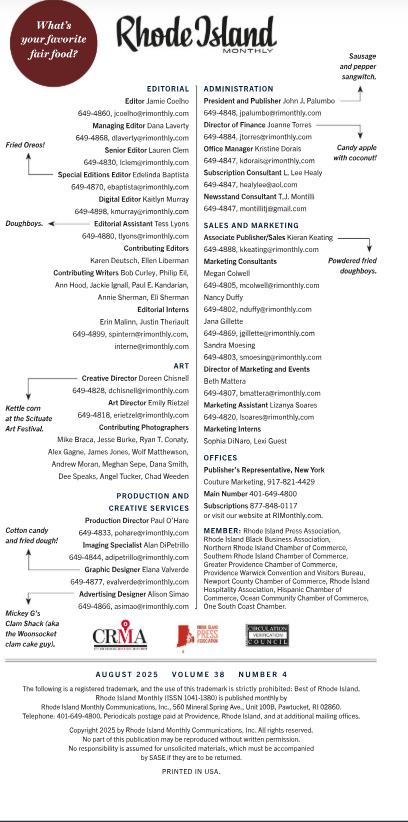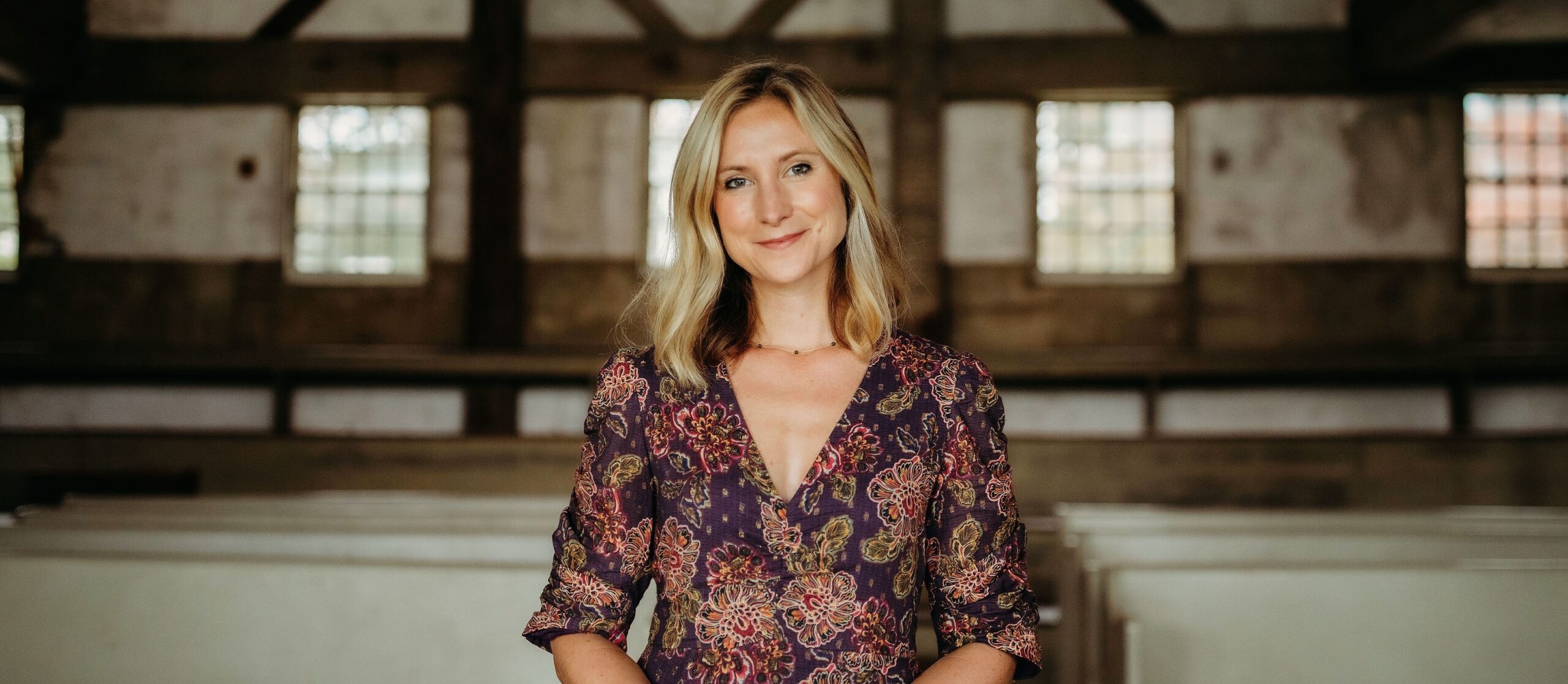“We live here, we have an office in Pawtucket, anyone (and many do) can walk into and request help. I respond to every email or letter addressed to me personally. We will not hide behind a wall of anonymity. And when we are wrong, we take it on the chin and respond accordingly.”
Thanks for doing this, John. We go back a long way! – to when we both worked at The Providence Journal. Many fond memories though seems like an eternity ago now. From those early days, you have built Rhode Island Monthly into a Rhode Island powerhouse. Can you give us a quick recap of the magazine from then to today?
I am fast approaching 30 years as publisher so to summarize highlights and lowlights would be challenging. I guess, in basis metrics, I can say we are about three times as large from a revenue perspective. Our circulation/readership, despite the blips of economic recession, supply chain issues, and the pandemic, has remained remarkably steady. After almost a decade at the newspaper, I thought I knew pretty much all I needed to know about publishing, and boy, was I wrong. I guess the latest and greatest development is the explosion of our digital presence, which is unique content and a fast-growing audience on the web and social media. We have approximately 200,000-250,000 page views per month. That means having resources to create that content for the audience, despite, from a financial perspective, getting a fraction of return on investment in terms of advertising and sponsored content.
Like so many Rhode Islanders, I am a loyal subscriber. The latest issue, the annual Best of Rhode Island edition, 160 pages long with 459 winners, includes an editorial by you on page 14 that’s headlined ‘Local, Local, Local.’ What prompted you to pen it?
When I first started I would regularly check in with the publishers of Providence Business News, the locally owned weekly groups as respected competitors. Gradually, I watched them all disappear, sold off to out-of-state entities. I suddenly realized that we were the last statewide, locally published print publication in the market. That was indeed a surreal moment and fueled my fervor to promote the hometown team. I often wince when I am watching local network television and some poor young reporter, who has just shipped into Providence from God-knows-where, is mispronouncing Chariho live on air.
We live here, we have an office in Pawtucket, anyone (and many do) can walk into and request help. I respond to every email or letter addressed to me personally. We will not hide behind a wall of anonymity. And when we are wrong, we take it on the chin and respond accordingly.

You write that your magazine’s commitment to local coverage is built on three pillars. Can you please elaborate on each, starting with “local knowledge.”
We live here and in many cases we employ lifelong Rhode Islanders who are as comfortable recapping childhood memories of Rocky Point as well as dishing on the latest culinary developments. And yes there are some generational knowledge gaps amongst the younger staff and old guys like me ( I have six folks out of 24 that have been with the magazine more than 25 years). We take the time to provide perspective, like why Rhode Island was deemed an amusement park for journalists by Elliot Jaspin, the former projo reporter. We are involved in community organizations. At one point I served on six boards and just wrapped 28 years on the board of the zoo. Jamie, our editor, is frequently out at food events, judging competitions and the like. Lauren Clem is an advisor to The Little Sisters of The Poor in Pawtucket.
And what about local journalists, “in many cases, homegrown.”
We have six editors on staff and three of them are former Rhode Island Monthly interns. At one point we had six (on total staff not just editors) I think you either catch the passion for what we do-long form lifestyle journalism or not. The young people we hire know us and we know them and our mutual expectations.
Finally, tell us about “local, independent ownership.”
In 2008, the great economic collapse was upon us. We (The Providence Journal and Rhode Island Monthly) were owned by AH Belo in Dallas. Belo took a top-down approach in establishing budgets and earnings expectations for all operating units. So, the expectations for a relatively small regional pub were the same as for the Dallas Morning News proportionality. When we received budget guidelines for the following year, it became apparent that we were doomed. Budget cuts would have required terminating a third of the small staff and increasing the workload. I decided to make a huge leap of faith and negotiated to purchase the magazine. That means no bureaucracy, no task forces, no research groups. It is a decide fast, act fast and react fast environment. And not only on the business front. When Matunuck Oyster Bar established the employee fund after the fire, no red tape- we cut the check on the first day.
We note, too, that you have a physical office. Where is it, and can people visit?
After a decade on Allens Avenue in Providence, we moved to Pawtucket in March of 2020 just in time to feel the full brunt of the pandemic shutdown. It was a good six months to a year before we were functioning as I had intended when designing the space. The building is Lorraine Mills at 560 Mineral Spring Avenue. Right next to what I call the RIM cafeteria, the Miss Lorraine Diner.
In other issues throughout the year, Rhode Island Monthly reports on business, health, wellness, culture, history, sports, music, art, food and drink, film, festivals and more. It does so with a stellar staff. Let’s hear a bit about some of them, starting with editor Jamie Coelho.
Jamie’s passion is food journalism and everything related to it. As I mentioned earlier, despite being a working Mom with two young children, she is out and about constantly. She is celebrating 15 years with the magazine and has assumed her current position, managing a staff of six and a growing array of talented contributors. She is an avid social media user, personally and for the magazine. And she is frequently the face /voice of RIM on television and radio.
And managing editor Dana Laverty.
The projo’s loss is our gain. A former Journal staffer, she joined us from AAA a few years ago and brings a seasoned perspective and a calm management style, one can only gain from a stint at the state ‘s major daily. She has been masterful in leading the team in big projects like last year’s Pride issue and, more recently, our Rocky Point retrospective. She is also our “den mom,” coaching the younger of the staff, providing tips and guidance. Dana keeps the team organized on schedule and focused on the tasks at hand.
And senior editor Lauren Clem.
Lauren is a former intern when she was an undergraduate at Villanova. Post-graduation, she worked for The Rhode Island Catholic, then became assistant editor of The Valley Breeze newspapers. She joined us a few years ago and has become true star on the rise. She has attacked complex civic journalism topics ( for a lifestyle magazine) such as climate change and homelessness in Rhode Island. She manages our annual DEI awards recognition program, The Bannister Awards
You also hire freelancers and rely on a large support staff of folks in production, sales, marketing, art, and creative services. We can’t list them all but we do want to give them a shoutout.

We are fortunate to have several seasoned journalists and projo alums writing for us, such as Ellen Lieberman, Ged Carbone, Mike Stanton, and Andy Smith. Eli Sherman of WPRI has penned more than one investigative piece. And our September cover story is a piece by current Providence Journal reporter Tom Mooney.
Finally, what can we expect from Rhode Island Monthly in the future?
I hesitate to publicly state lofty goals especially in the print arena. We would like to continue to grow some of our contract work (catalogues for Cardi’s Furniture and Mattresses and a magazine for The Brown Physicians group are current projects). I would also like to unlock the secret of adequately monetizing digital assets given the extent of the staffing/expense.
When I first read this question, my reaction was” define future- tomorrow, next week or next month?” Like I said we survive in a decide-fast, act-fast, react-fast world. I should add that means change course as fast as needed.

Editor’s note: This interview was conducted by email.






